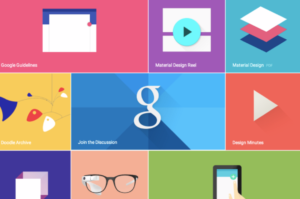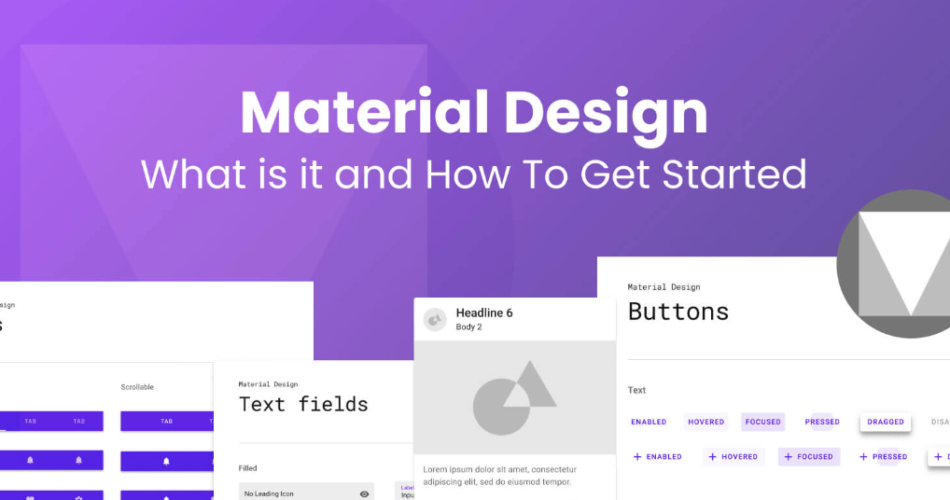Material Design is a design language developed by Google in 2014, aimed at creating a unified and intuitive user experience across all platforms and devices. It blends the principles of good design with innovation and technology, resulting in interfaces that are not only aesthetically pleasing but also highly functional. This guide will delve into the core principles of Material Design, its key components, and how it has transformed the digital landscape.

Material Design
Contents
The Principles of Material Design
Material Design is built on three main principles:
- Material is the Metaphor:
- Material Design uses the concept of physical materials to create a sense of space and hierarchy. It mimics the way light, surface, and movement interact in the real world, providing a familiar and intuitive experience for users. Elements like edges, shadows, and dimensions help to convey how objects can be manipulated and interacted with.
- Bold, Graphic, Intentional:
- Emphasis is placed on bold colors, large typography, and intentional white space. This principle ensures that the design is visually striking and easy to read, helping users to focus on the content that matters. By using a deliberate color palette and visual treatments, Material Design aims to create a cohesive and engaging user interface.
- Motion Provides Meaning:
- Movement and transitions are key in Material Design, providing continuity and guiding users through interactions. Thoughtful animations and transitions help to establish relationships between elements, indicate changes, and focus the user’s attention. Motion not only makes the experience more dynamic but also provides feedback and maintains user engagement.
Key Components of Material Design
Material Design encompasses various components that work together to create a seamless user experience. Some of the essential components include:
- Material Components:
- These are pre-built design elements that follow Material Design guidelines. They include buttons, cards, lists, dialogs, and more. These components ensure consistency across different applications and platforms, making it easier for designers and developers to create cohesive experiences.
- Typography:
- Material Design places significant importance on typography, using a system that scales across different devices and screen sizes. The type system is designed to be legible and hierarchical, ensuring that users can easily read and understand the content.
- Color:
- The color system in Material Design is dynamic and customizable, allowing designers to create visually distinct themes. The use of primary and secondary colors, along with accent colors, helps to create a vibrant and harmonious interface.
- Icons and Imagery:
- Icons and images are essential elements in Material Design, providing visual cues and enhancing the overall aesthetic. Icons are used to represent actions, features, and navigational elements, while imagery adds context and emotional impact.
- Layout:
- The layout system in Material Design is based on a responsive grid, ensuring that the design adapts to different screen sizes and orientations. This flexibility allows for a consistent user experience across mobile, tablet, and desktop devices.
The Impact of Material Design
Since its introduction, Material Design has had a profound impact on the digital landscape. It has become a widely adopted design language, influencing the aesthetics and functionality of countless applications and websites. Some of the key benefits of Material Design include:
- Consistency:
- By following a unified set of guidelines, Material Design ensures a consistent user experience across different platforms and devices. This consistency helps users to navigate and interact with digital products more intuitively.
- Efficiency:
- Material Design provides a comprehensive framework that streamlines the design and development process. With pre-built components and a clear set of principles, designers and developers can create high-quality interfaces more efficiently.
- User Satisfaction:
- The focus on usability, accessibility, and visual appeal in Material Design enhances user satisfaction. Thoughtful design elements and interactions create a pleasant and engaging experience, encouraging users to return to the product.
Conclusion
Material Design has revolutionized the way digital products are designed, offering a cohesive and intuitive approach that prioritizes user experience. By embracing the principles of Design, designers and developers can create interfaces that are not only beautiful but also functional and user-friendly. As technology continues to evolve, Design will undoubtedly remain a cornerstone of modern interface design, shaping the future of digital experiences.
